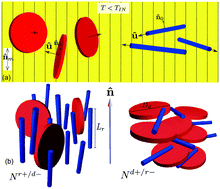Frank elasticity of composite colloidal nematics with anti-nematic order
Abstract
Mixing colloid shapes with distinctly different anisotropy generates composite nematics in which the order of the individual components can be fundamentally different. In colloidal rod-disk mixtures or hybrid nematics composed of anisotropic colloids immersed in a thermotropic liquid crystal, one of the components may adopt so-called anti-nematic order while the other exhibits conventional nematic alignment. Focussing on simple models for hard rods and disks, we employ Onsager–Straley's second-virial theory to derive scaling expressions for the elastic moduli of rods and disks in both nematic and anti-nematic configurations and identify their explicit dependence on particle concentration and shape. We demonstrate that the splay, bend and twist elasticity of anti-nematically ordered particles scale logarithmically with the degree of anti-nematic order, with the bend–splay ratio for anti-nematic discotic nematics being far greater than for conventional nematic systems. The impact of surface anchoring on the elastic properties of hybrid nematics will also be discussed in detail. We further demonstrate that the elasticity of mixed uniaxial rod–disk nematics depends exquisitely on the shape of the components and we provide simple scaling expressions that could help engineer the elastic properties of composite nematic liquid crystals.



 Please wait while we load your content...
Please wait while we load your content...